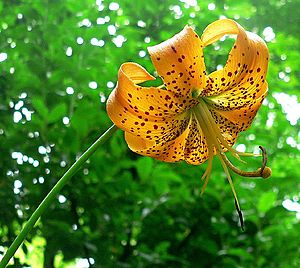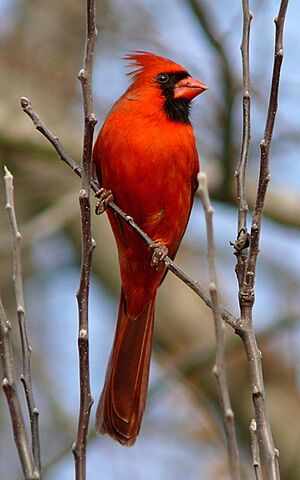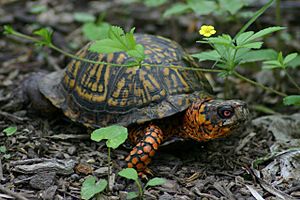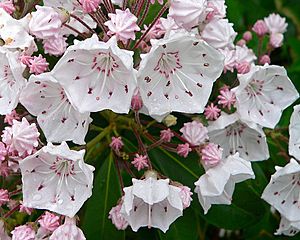Wildlife of North Carolina facts for kids
North Carolina is a state in the United States with an amazing variety of plants and animals! This guide will help you discover the cool creatures and beautiful plants that call North Carolina home. From tiny insects to large bears, and from towering trees to colorful flowers, there's so much to explore in this special state.
Contents
North Carolina's Natural World
North Carolina is super unique because it has three main natural areas, called biomes. These are like different neighborhoods for plants and animals, each with its own climate and features. These areas are the Coastal region, the Piedmont, and the Appalachian Mountains.
Even though North Carolina is in a temperate zone (meaning it has four distinct seasons), the huge Appalachian Mountains and the warm Gulf Stream ocean current really affect its weather. This is why you can find plants and animals that usually live in sub-tropical, temperate, and even cold, northern places all within North Carolina's borders!
The Coastal Region
The eastern part of North Carolina is called the coastal region. It's much warmer and more humid here. The weather is like a humid subtropical climate, and the land is mostly flat, forming a coastal plain.
The Piedmont
This middle region includes big cities like Charlotte, Raleigh, and Durham. It also has lots of rolling hills, which are like gentle slopes, and flat valleys. The climate here is also humid subtropical. The Piedmont's elevation changes from about 300–400 feet (90–120 meters) in the east to over 1,000 feet (300 meters) in the west.
The Mountains

The western part of North Carolina is home to the Appalachian Mountains. The climate here is a humid continental climate, which means it has colder winters and warmer summers than the coast. The mountains range from 1,500 feet to over 6,000 feet high!
Amazing Animal Life
North Carolina is home to many different kinds of animals, from tiny insects to large mammals. Some of these animals are very special and need protection.
Mammals
Mammals are warm-blooded animals that have fur or hair and feed their babies milk. North Carolina has many mammals, including some that are endangered or have been brought back to the state.
- `E` means the animal is Endangered, which means there are very few left, and they need special protection.
Opossums:
- Virginia opossum, Didelphis virginiana
Armadillos:
- Nine-banded armadillo, Dasypus novemcinctus
Rodents:
- North American beaver, Castor canadensis (These animals were brought back to North Carolina after disappearing for a while.)
- Northern flying squirrel, Glaucomys sabrinus (The Carolina northern flying squirrel, G. s. coloratus, is `E`.)
- Southern flying squirrel, Glaucomys volans
- Groundhog, Marmota monax
- Rock vole, Microtus chrotorrhinus
- Meadow vole, Microtus pennsylvanicus
- Woodland vole, Microtus pinetorum
- Southern red-backed vole Myodes gapperi
- Woodland jumping mouse Napaeozapus insignis
- Eastern woodrat, Neotoma floridana
- Golden mouse Ochrotomys nuttalli
- Muskrat, Ondatra zibethicus
- Marsh rice rat, Oryzomys palustris
- Cotton mouse, Peromyscus gossypinus
- White-footed mouse, Peromyscus leucopus
- Eastern deermouse, Peromyscus maniculatus
- Oldfield mouse, Peromyscus polionotus
- Eastern harvest mouse, Reithrodontomys humulis
- Eastern gray squirrel, Sciurus carolinensis (This is North Carolina's official state mammal!)
- Fox squirrel, Sciurus niger
- Hispid cotton rat Sigmodon hispidus
- Southern bog lemming, Synaptomys cooperi
- Eastern chipmunk, Tamias striatus
- American red squirrel, Tamiasciurus hudsonicus
Lagomorphs (Rabbits and Hares):
- Snowshoe hare, Lepus americanus (This animal is now extirpated from North Carolina, meaning it no longer lives there.)
- Swamp rabbit, Sylvilagus aquaticus
- Eastern cottontail, Sylvilagus floridanus
- Appalachian cottontail, Sylvilagus obscurus
- Marsh rabbit, Sylvilagus palustris
Eulipotyphlans (Moles and Shrews):
- Star-nosed mole, Condylura cristata
- Eastern mole, Scalopus aquaticus
- Northern short-tailed shrew, Blarina brevicauda
- Southeastern shrew, Sorex longirostris
Bats:
- Townsend's big-eared bat, Corynorhinus townsendii (The Virginia big-eared bat, C. t. virginianus, is `E`.)
- Northern yellow bat Dasypterus intermedius
- Big brown bat, Eptesicus fuscus
- Eastern red bat Lasiurus borealis
- Hoary bat Lasiurus cinereus
- Seminole bat Lasiurus seminolus
- Gray bat, Myotis grisescens `E`
- Eastern small-footed bat Myotis leibii `E`
- Northern myotis, Myotis septentrionalis
- Indiana bat, Myotis sodalis `E`
Carnivorans (Meat-Eaters):
- Coyote, Canis latrans
- Red wolf, Canis rufus `E` (These have been brought back to North Carolina.)
- North American river otter, Lontra canadensis
- Bobcat, Lynx rufus
- Striped skunk, Mephitis mephitis
- Eastern spotted skunk, Spilogale putorius
- Least weasel, Mustela nivalis
- Long-tailed weasel, Neogale frenata
- American mink, Neogale vison
- Fisher, Pekania pennanti (This animal is now extirpated from North Carolina.)
- Raccoon, Procyon lotor
- Cougar, Puma concolor (This animal is now extirpated from North Carolina.)
- Eastern cougar, P. c. couguar
- Gray fox, Urocyon cinereoargenteus
- American black bear, Ursus americanus
- Red fox, Vulpes vulpes
- Harbor seal, Phoca vitulina
Even-toed Ungulates (Hoofed Mammals):
- American bison, Bison bison (This animal is now extirpated from North Carolina.)
- Elk, Cervus canadensis (These have been brought back to North Carolina.)
- Eastern elk, C. c. canadensis
- Rocky Mountain elk, C. c. nelsoni (These were introduced to North Carolina.)
- White-tailed deer, Odocoileus virginianus
- Wild boar, Sus scrofa (These were introduced to North Carolina.)
Birds

North Carolina is a great place for birdwatching! You can find many different kinds of birds, from tiny hummingbirds to large eagles. To learn more, check out the List of birds of North Carolina.
Reptiles

Reptiles are cold-blooded animals with scales. North Carolina has many types of snakes, lizards, and turtles. The Eastern Box Turtle is even the state reptile! You can find a full list of these amazing creatures at the List of reptiles of North Carolina.
Amphibians

Amphibians are animals that can live both on land and in water, like frogs and salamanders. Frogs are very common in the wet areas of North Carolina's Piedmont region. The frog in the picture is likely a Cope's gray treefrog (Hyla chrysocelis). It's hard to tell the difference between this one and a gray treefrog (H. versicolor) without hearing their calls or doing special tests.
Some common amphibians in North Carolina include:
- Two-toed amphiuma
- Common mudpuppy
- Dwarf waterdog
- Eastern lesser siren
- Greater siren
- Red-spotted newt
- Mabee's salamander
- Spotted salamander
- Marbled salamander (This is North Carolina's official state salamander!)
- Mole salamander
- Eastern tiger salamander
- Southern dusky salamander
- Dwarf salamander
- Four-toed salamander
- Wehrle's salamander
- Eastern spadefoot
- Southern toad
- Pine Barrens treefrog (This is North Carolina's official state frog!)
- Cope's gray treefrog
- Green treefrog
- Squirrel treefrog
- Gray treefrog
- Little grass frog
- Ornate chorus frog
- Upland chorus frog
- American bullfrog
- Bronze frog
- Pickerel frog
- Southern leopard frog
- Wood frog
Fish
North Carolina has many different fish, both in its freshwater rivers and lakes, and in the saltwater ocean.
Freshwater Fish:
- Bodie bass, Roanoke bass, largemouth bass, rock bass, smallmouth bass, spotted bass, striped bass, white bass
- Blue catfish, channel catfish, flathead catfish, white catfish, brown bullhead
- White perch, yellow perch
- Chain pickerel, redfin pickerel
- American shad, hickory shad
- Pumpkinseed, redear, bluegill, flier, green sunfish, redbrest, warmouth
- Brook trout, rainbow trout, brown trout
- Garfish, bowfin, carp, crappie, freshwater drum, grass carp, kokanee salmon, muskellunge, tiger muskellunge, northern pike, sauger, eastern mosquitofish, smallmouth buffalo, walleye
- The unique Cape Fear shiner (This fish is only found in the Cape Fear River basin!)
Saltwater Fish:
- Albacore, amberjack, Atlantic bonito, Atlantic tarpon, bank sea bass, barracuda, bigeye tuna, blackfin tuna, black drum, black sea bass, blacktip shark, bluefish, bluefin tuna, blue marlin, blueline tilefish, bull shark, butterfish, cobia, croaker, dolphinfish, flounder, gag, gray triggerfish, gray trout, hammerhead sharks, hickory shad, hogchoker, hogfish, humping mullet, king mackerel, knobbed porgy, lizardfish, little tunny, mako shark, menhaden, northern puffer, oyster toadfish, pigfish, pinfish, pompano, red drum, red grouper, red snapper, sailfish, scamp, sea mullet, searobin, sheepshead, silver perch, silver snapper, skate, skipjack tuna, spadefish, Spanish mackerel, speckled hind, spottail pinfish, spot, speckled trout, stingray, striped bass, swordfish, tiger shark, vermillion snapper, wahoo, white marlin, white grunt, yellowfin tuna, yellowedge grouper and yellowtail snapper.
Invertebrates
Invertebrates are animals without backbones. This group includes many different creatures like insects, spiders, jellyfish, millipedes, centipedes, freshwater crayfish, and freshwater mollusks.
- Northern black widow (Latrodectus variolus)
- Southern black widow (Latrodectus mactans)
- False black widow (Steatoda grossa)
- Common house spider (Parasteatoda tepidariorum)
- Yellow garden spider (Argiope aurantia)
- Leafy cob weaver (Theridion frondeum)
- Spiny-backed orbweaver (Gasteracantha cancriformis)
- White sac spider (Elaver excepta)
- Orchard orb weaver (Leucauge venusta)
Mantises:
- Carolina mantis (Stagmomantis carolina)
Hymenoptera (Bees, Wasps, Ants):
- European honey bee (Apis mellifera) (This is North Carolina's official state insect!)
- American bumblebee (Bombus pensylvanicus)
- Eastern carpenter bee (Xylocopa virginica)
- Red paper wasp (Polistes carolina)
- Eastern cicada killer (Sphecius speciosus)
- Red velvet ant (Dasymutilla occidentalis)
- Red imported fire ant (Solenopsis invicta)
Odonata (Dragonflies and Damselflies):
- Eastern pondhawk (Erythemis simplicicollis)
Lepidopterans (Butterflies and Moths):
- Monarch butterfly (Danaus plexippus)
- Red-spotted purple (Limenitis arthemis)
Wonderful Plant Life

North Carolina is also home to an incredible variety of plants, from towering trees to beautiful wildflowers. These plants provide food and shelter for all the animals mentioned above. To learn more about the plants of North Carolina, you can visit the List of flora of North Carolina.
Images for kids



